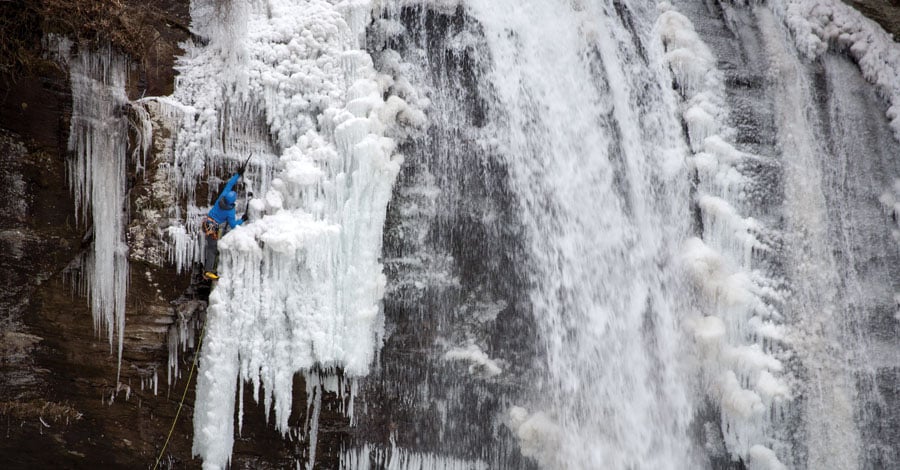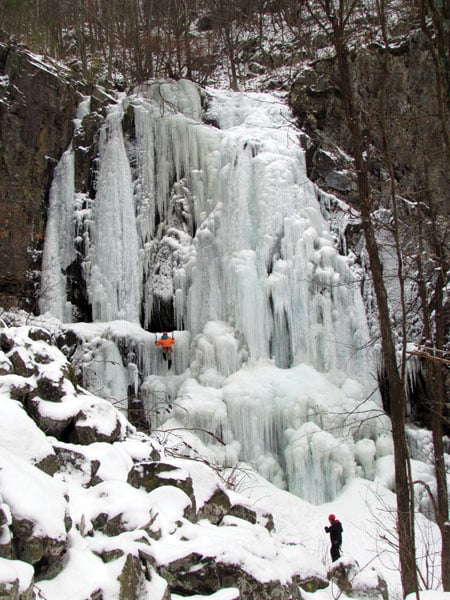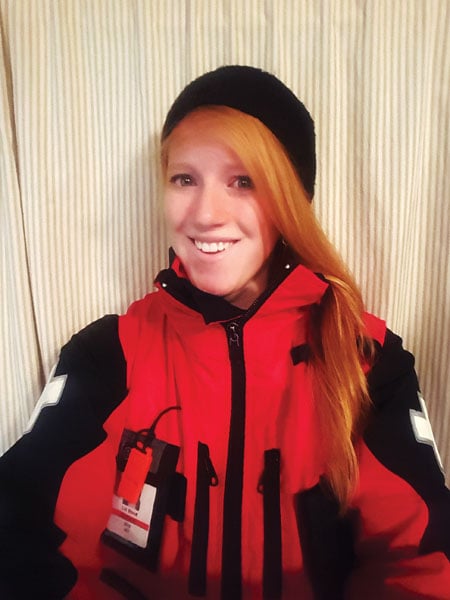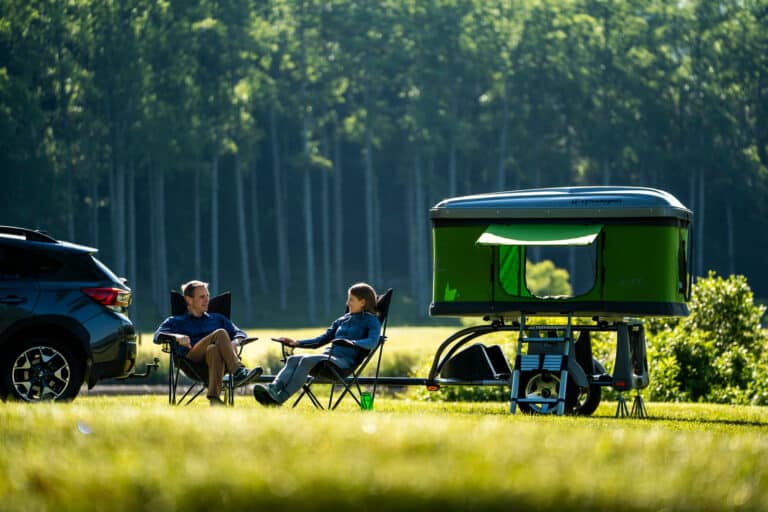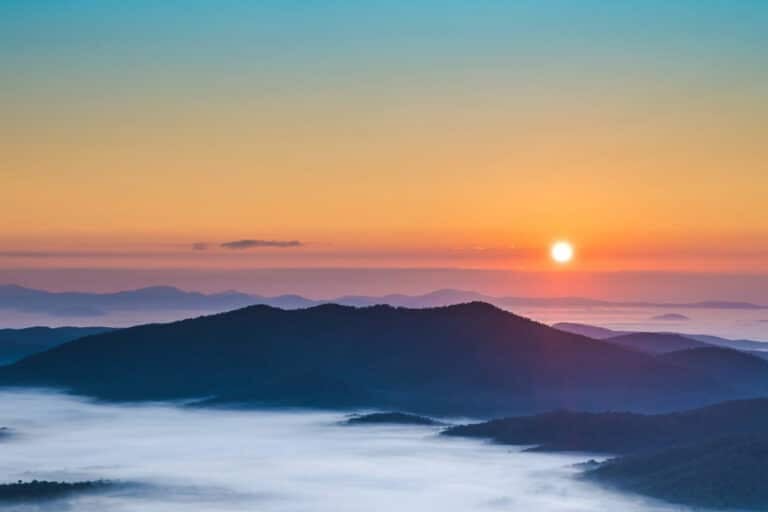CLIMBING-BUM-TURNED-PRO
Karsten Delap
Owner/Guide, Fox Mountain Guides and Climbing School
Age: 35
Hails from: Southern Indiana
Calls home: Western N.C.
Admit it. There are a handful of adventure-themed Instagram handles you occasionally (and by occasionally I mean daily) cyberstalk, the ones with images of climbers and hikers staged before almost impossibly epic mountainscapes.
To most, these Instagram handles are intended to inspire, to motivate, but for Karsten Delap, dramatic landscapes and gritty adventure are par for the course. As a professional rock and alpine guide, Delap’s own Instagram handle (@karstendelap) is peppered with alpine summit photos from around the world. Since quitting his “real job” back in 2005 to pursue climbing in the Red River Gorge, Delap has climbed extensively throughout the United States and in 30 different countries, from France to Bolivia.
In 2013, Delap became the first guide in the Southeast to achieve his certification as an American Mountain Guides Association (AMGA) Alpine Guide, and now owns Fox Mountain Guides (FMG) based out of Pisgah Forest, N.C. For most of the year, Delap is far from FMB headquarters, guiding trips on some of the world’s most revered peaks like Aconcagua in Argentina and Mount Whitney in California. No matter the exotic spread of travels that await him, though—Delap is proud to call western North Carolina home.
In between guiding trips, Delap works volunteer shifts with three local rescue teams as their expert in high angle, technical, and wilderness rescue. Additionally, he serves on the board of directors for AMGA and the Appalachian Mountain Rescue Team. On the rare occasion that Delap has time off from those duties, you can still find him repping his sponsors (La Sportiva, Deuter, Ibex Outdoor Clothing, Blue Water Ropes, and Julbo Eyewear) on the rock or up an ice flow doing what he does best.
WHAT MADE YOU DECIDE TO CHASE CLIMBING AS A CAREER?
I was working in sales after college. I didn’t really take to being in front of a computer all day!
WHY RELOCATE TO WESTERN NORTH CAROLINA?
It was the closest area [from southern Indiana] where I could start working in the rock climbing realm. The western mountains of North Carolina offer a variety of climbing, from easy bouldering at Rumbling Bald to big ice climbs. It’s a pretty rad place.
HAVE YOU FOUND ANYTHING CLOSE TO AN ALPINE EXPERIENCE IN THE SOUTHEAST?
There’s very fringe ice climbing. Ice in North Carolina is super finicky. It’s in one week and out the next. You don’t come to North Carolina and expect to climb ice—you come to North Carolina and you get to climb ice…if it’s in.
WHEN WAS THE LAST TIME YOU GOT TO CLIMB ICE IN YOUR BACKYARD?
It was last year. Looking Glass Falls had frozen over. Well, it froze, but it wasn’t like, completely frozen. I knew it was one of those climbs that was going to be super committing. The gear was no good. I could feel the icicle moving.
WHAT IS YOUR TAKE ON RISK VERSUS REWARD?
When you’re climbing or doing these activities in the outdoors, you have the luck jar. You’re trying not to use the luck in your luck jar, so you push risk management to the edge, but sometimes you don’t know where that edge is and you just have to hope that if you need luck, there’s still luck in that jar.
DOES ANYONE IN YOUR FAMILY SHARE YOUR LOVE OF ADVENTURE?
I got [my father] up to Grand Teton and did some multipitch climbing. Now he’s going to the Red [River Gorge] every other weekend. He’s loving it. The Tetons wrecked him—it was an awesome trip, but even before we got on the plane to go back home, it was like, “What’s next?” I don’t know what I’ve started here, but the Bugaboos in Canada are next. He’ll be 61 this year.
THE MOUNTAIN MAN
Dustin Sanderson
Owner/Guide, Capital Climbing Guides
Age: 33
Hails from: Abilene, Texas
Calls home: Washington, D.C.
This is the guy you wish you could be. Kayaker, climber, skier, mountain biker, beard grower. Don’t be surprised if and when you see Dustin Sanderson’s mug on the next cover of GQ.
By day, Sanderson works as the Assistant Director for the Voyageur Program, an outdoor experiential education opportunity provided as an elective to students in grades four through 12 at the National Cathedral School for Girls and the St. Albans School for Boys.
When he’s not teaching students to roll a kayak or tie a figure eight, Sanderson gets after it on the weekends by boat, bike, boot, whatever means necessary. He’s an all-around outdoorsman, a connoisseur au dehors, but come winter, Sanderson usually has just one thing on his mind—ice. Considering he lives in the heart of D.C., this may appear to be a poor choice in hobby, yet Sanderson takes his playtime seriously. Every weekend is usually spent tromping through the elements in search of ice climbing nearby in Shenandoah National Park.
Over the years, and through countless hours bushwhacking around the park, Sanderson has found some real gems, including a few ice flows scaling over 100 feet in height.
HOW WERE YOU INTRODUCED TO ICE CLIMBING?
When I started working with Outward Bound up in Maine, that was one of the first times I’d been exposed to ice climbing. They offered up a lot of warnings, saying, “If you start down that road, it’s a slippery slope.” It is an expensive sport, more so than climbing in some regards, but I ignored all of their warnings. Nothing sounds better than slinging tools into ice and bashing my way up things.
MOVING FROM MAINE TO D.C. SOUNDS LIKE A BIG CHANGE IN PACE. HOW HAS THE CAPITAL FARED IN THE WAY OF ADVENTURE?
I’ve been pleasantly surprised at the amount of outdoor recreation opportunity. [Working for the Voyageur Program], I can actually be in whitewater or be climbing every day of the week and that’s the full-time gig, so, maybe there’s more than meets the eye to D.C.
SO ICE? IN THE SHENANDOAHS? IS THERE ANYTHING GOOD?
If you understand the geology of the Shenandoahs, there are certain elevations where there are naturally some rock bands that form, which are not necessarily fantastic cliffs for climbing, but they also produce some springs or seeps that are fantastic at forming these ice flows.
WHAT MADE YOU START EXPLORING THE SHENANDOAHS FOR ICE?
A couple of years ago, the cover of Rock and Ice was a picture of a particular ice climbing area in the Shenandoahs. I said to myself, “I need to find this.”
WHY ICE CLIMBING? WHAT KEEPS YOU COMING BACK?
I enjoy it because it’s very different from rock climbing. It’s such a short window, especially in the Mid-Atlantic. We’re looking only at two months of good quality ice conditions. We’re getting on it while it’s hot, or cold for that matter. It’s the thrill of the chase.
THE GIRL THAT SHREDS HARDER THAN YOU
LIZ STOUT
National Ski Patroller, Canaan Valley Resort State Park and Timberline Four Seasons Resort
Age: 26
Hails from: Elkins, W.Va.
Calls home: Elkins, W.Va.
If you’re lucky, you may catch a glimpse of Liz Stout’s red braids as she flies past you on the slope, elegantly carving practice turns on a set of telemark skis. Unless you catch her on a lunch break, you’d be hard-pressed to make this go-getter sit still and chitchat. Between working 9 to 5 as a biologist for U.S. Fish and Wildlife Service and double shifts on the weekend with pro ski patrol for Canaan Valley Resort State Park and Timberline Four Seasons Resort, Stout barely has time to train for her 50-mile endurance horseback rides (only barely—she still rides nearly every evening).
Born and raised in the mountains of West Virginia just an hour’s drive from three major ski areas, Stout has been sliding down slopes on a pair of alpine skis since the age of four. She only recently made the transition to tele skis after joining patrol in 2011, but you’d never be able to tell.
She’s a solid athlete with a pretty smile and contagious sense of adventure. She can follow even the rowdiest of backcountry tree lines and rarely complains, even when she has a second-degree AC separation and has to lug 100-pounds in toboggans for patrol training.
WHY THE SWITCH TO TELEMARK?
Once I joined patrol, I had free lessons all of the time. It was neat to learn how to better manipulate the skis I was on and better maneuver the terrain. The flow with the motion of tele opened up some other terrain that I hadn’t considered before. I started seeing the mountains in a different way, which was refreshing because I’ve lived here my whole life.
EMERGENCY RESPONSE AND SKIING ASIDE, HAS WORKING SKI PATROL TAUGHT YOU ANY UNIQUE SKILLS?
I’ve mastered the art of driving a car with ski boots.
WHAT ARE SOME OF THE WORST INJURIES YOU’VE HANDLED ON THE MOUNTAIN?
You usually see a lot of shoulders—clavicle fractures or an AC separation—wrist fractures, a couple of them with a lot of deformity where you’re like, oh yes, that’s not right. I’ve had two unresponsive-unconscious patients who were both epileptic and a patient with an impaled object in his ear. I don’t know what that person was thinking.
HAVE YOU EVER SUFFERED FROM ANY SKI-RELATED INJURIES YOURSELF?
All of my injuries have come from skiing—a broken elbow, broken collarbone, second-degree AC separation, bruised and maybe cracked some ribs.
DO YOU HAVE ANY FEMALE CO-PATROLLERS?
On pro patrol at Canaan, I’m one of two women on a staff of 25. At Timberline, I’m one of four or five out of 35. We’re not many and it’s not surprising that there aren’t as many women. It’s a dog eat dog world and you have to have a thick skin to handle it.
WHY WORK PATROL ON THE WEEKENDS WHEN YOU COULD JUST AS EASILY SKI FOR FUN?
I like the camaraderie that comes from working with a group of people in some high-stress situations, which can go from nothing to crazy in just the blink of an eye. It can be challenging but I really find it rewarding.
THE COACH
CHRIS SHEPARD
Winter Teams Director, Wintergreen Resort
Age: 51
Hails from: Shipman, Va.
Calls home: Nelson County, Va.
The path to coachdom is undoubtedly rooted in passion. Chris Shepard’s story is no exception. Despite growing up near a handful of ski resorts in western North Carolina, Shepard didn’t start skiing until he enlisted in the Army at age 18. Stationed among the towering peaks of the Bavarian Alps, Shepard became enraptured with the sport after his first ski vacation.
Two winters later, Shepard took a position at the Armed Forces Recreation Center in Germany where he skied to his heart’s content. For five years, Shepard took solace in the snow-capped sea of crests and German beer. When he returned to the East Coast in ’89, he easily found work at Sugar Mountain Resort in North Carolina, but something within was whispering, silently at first, then more loudly—go north.
On a whim, Shepard listened to his instinct, landing at Wintergreen Resort in central Virginia the winter of 1990-91. As fate would have it, Shepard met his now-wife, a native of the Nelson County area. Three kids, two dogs, and some fish later, Shepard still gets after it on the slopes of Wintergreen with nearly 200 ski and snowboard students under his guidance.
His wanderlust for velvet powder, however, is far from satisfied. As part of Wintergreen’s training program, Shepard incorporates multiday trips to world-renowned ski destinations, most recently Austria’s Hintertuxer Gletscher. When the snow melts in Virginia, Shepard can be found on a plane bound for Oregon to beat the heat with a little dose of summer skiing.
HOW HAS THE SCENE AT WINTERGREEN CHANGED SINCE YOU FIRST ARRIVED 25 YEARS AGO?
The climate in the Southeast for skiing is always going to be desolate. I’ve seen so many unpredictable weather patterns. The most amazing thing is we seem to, occasionally, every two or three years, have situations where we get upwards of 30 inches of snow. It’s pretty exciting.
THE BLUE RIDGE MOUNTAINS ARE CERTAINLY NO BAVARIAN ALPS WHEN IT COMES TO SKIING, SO WHY STAY AT WINTERGREEN?
Meeting my wife, getting married, having a family, and with Wintergreen so close by, it worked perfectly together. The fact that [the resort] was member-owned made the whole work experience different than other places. When you see these families every weekend, you develop a relationship and feel like you’re part of their family.
WHAT HAS BEEN ONE OF YOUR PROUDEST MOMENTS IN MANAGING THE RACE TEAMS AT WINTERGREEN?
Even though we have a girl that made it to the women’s World Cup Development Team, the number of kids’ lives we’ve touched is probably the best thing that we do. Some of our best success stories are the kids who didn’t meet the skill requirements to race. When those kids get to be 14 to 15 years old, they are all of a sudden excellent skiers and will be for the rest of their lives.
THERE’S NO DOUBT YOU LOVE SKIING, BUT WHAT ABOUT THE WINTER SEASON?
I would go crazy if it was winter all of the time, or summer all of the time. But what a perfect place here [in Virginia]. You’re three hours from the beach and the mountains are right here.
THE WEATHERMAN
RAY RUSSELL
Mastermind, RaysWeather.Com
Age: 68
Hails from: Manchester, Tenn.
Calls home: Boone, N.C.
Dr. Ray Russell is a man of many talents. A minister with a Ph.D. in computer science and a running coach’s certification, Russell is mostly known around town as the weatherman. Self-taught in the art of meteorology, Russell first began reporting weather in the High Country after the blizzard of ’93 blew through Boone, bringing with it nearly 36 inches of snow. As a professor of computer science at Appalachian State University (a position he maintains to this day), Russell was one of the few who could decipher the inner workings of the Internet, which was then only in its infancy.
Using primitive web design, Russell crafted a snow report for western North Carolina on his university site, posting semi-regularly during the winters of 1994-96. By the time he received a weather station from his wife during the Christmas of ’98, Russell already had a well-established following of weather watchers.
Now, Russell’s forecast (raysweather.com) covers more than the High Country surrounding Boone, spanning the entire length of the Blue Ridge Parkway from Cherokee, N.C., to Waynesboro, Va. Though Russell now has five meteorologists working for him, he still updates daily forecasts for his hometown. The company’s annual Fearless Forecast has become like a Farmers’ Almanac to southern Appalachian powder hounds awaiting winter’s arrival.
CAN YOU REMEMBER THE FIRST TIME YOU EVER EXPRESSED INTEREST IN THE WEATHER?
When I was young, I bought every book a 10-year-old could get on meteorology and read. When you asked me what I was going to be when I grew up, well, I was going to be a meteorologist of course. As time went on, I did other things. The weather just kinda happened out of hobby and interest and accident.
WHEN WAS THE TURNING POINT FOR RAY’S WEATHER?
February of 2000. Unbeknownst to me, a local radio station started going to the site and looking at it. They wanted me to talk about weather on the radio. For the next three years, every day at 7:10, that became a staple of the radio station.
WHAT MAKES YOUR WEATHER FORECAST DIFFERENT?
If you go to weather.com, they’re going to tell you what the temperature is in Beech Mountain, but they don’t have any idea. They’re just guessing. With those national [weather] sources, there are no people behind that. It’s all computer generated. It goes from a computer model through some processing straight to the website or mobile device with no human brain that ever intervenes in that process.
DO YOU THINK YOUR ACCURACY HAS LED TO RAYSWEATHER.COM’S SUCCESS?
I call it my hobby gone berserk. I don’t really understand it all. Back in the day, I wrote some pretty zany things I couldn’t get away with anymore, but it was a creative outlet for me, not just the weather, but just to write something funny. We have a golf-o-meter for good days and snowman-o-meter for snow days. We’ll issue a white leg warning on the first warm day after winter, and if it’s windy, we’ll issue a big hair alert. We have fun with it but it’s a serious forecast.
SO WHAT’S OUR WINTER LOOKING LIKE?
It’ll be a slow start to winter, but snowier than average in the Foothills and throughout Southern Appalachia. The heart of our winter will begin late January and February.
